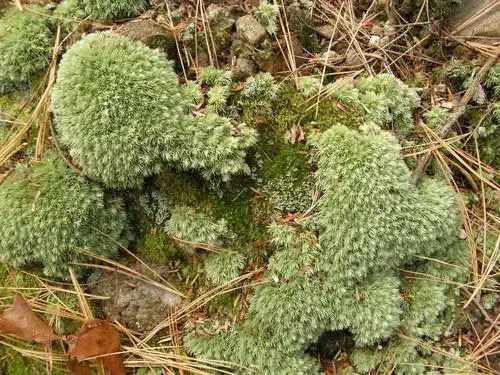
3922899869_3a2081ff1f_b.jpg from: https://www.flickr.com/photos/tanneberger/3922899869
Introduction
The world of mosses is a fascinating and often overlooked realm, home to a diverse array of species that play crucial roles in various ecosystems. Among these unsung heroes is the Leucobryum microcarpum Müll.Hal., a moss belonging to the Leucobryaceae family, commonly known as Leucobryum. This unassuming plant has captured the interest of bryologists and nature enthusiasts alike, thanks to its unique characteristics and ecological significance.
Background

16083595bb6b5297d4932aee5f359826.jpg from: https://openmuseum.tw/muse/digi_object/2355523fe7d6b11d4b7a8ac495911fd7
Before delving into the intricacies of Leucobryum microcarpum Müll.Hal., it’s essential to understand the broader context of mosses. These diminutive plants belong to the division Bryophyta, which encompasses three classes: Bryopsida (true mosses), Marchantiopsida (liverworts), and Anthocerotopsida (hornworts). Mosses are non-vascular plants, meaning they lack the specialized tissues found in vascular plants for transporting water and nutrients. Despite their small stature, mosses play vital roles in various ecosystems, acting as pioneers in colonizing disturbed areas, providing habitat for other organisms, and contributing to soil formation and water retention.
Main Content
Morphology and Identification
Leucobryum microcarpum Müll.Hal. is a acrocarpous moss, meaning its sporophytes (spore-bearing structures) grow at the tips of the stems. This species is characterized by its cushion-like growth form, with densely packed stems and leaves. The leaves are lanceolate (lance-shaped) and whitish-green in color, giving the moss a distinctive appearance. One of the most striking features of Leucobryum microcarpum Müll.Hal.

MountainMoss_Leucobryum_glaucum.jpg from: https://www.mountainmoss.com/collections/moss-trays/products/leucobryum
is its leaf structure, which consists of two distinct layers: a photosynthetic layer and a layer of hyaline (transparent) cells that act as a water-storage system.
Global Distribution and Habitat
Leucobryum microcarpum Müll.Hal. is widely distributed across various regions, including North America, Europe, Asia, and Australia. It thrives in a variety of habitats, such as coniferous and deciduous forests

3576885972_6af80846b4_z.jpg from: http://www.flickr.com/photos/72616463@N00/3576885972/
, bogs, and rocky outcrops. This moss prefers acidic and nutrient-poor environments, often colonizing areas with well-drained soils and partial shade.
Ecological Roles and Adaptations
Despite its small size, Leucobryum microcarpum Müll.Hal. plays crucial ecological roles in the ecosystems it inhabits. Its dense cushions provide microhabitats for various invertebrates, such as insects and arachnids, offering them shelter and protection. Additionally, the moss acts as a sponge, absorbing and retaining moisture, which helps regulate the local microclimate and prevent soil erosion.
One of the remarkable adaptations of Leucobryum microcarpum Müll.Hal. is its ability to desiccate (dry out) and rehydrate without suffering significant damage. This trait, known as poikilohydry, allows the moss to survive periods of drought and rapidly resume its metabolic activities when water becomes available again.
Case Studies/Examples
In a study conducted in the Pacific Northwest

medium.jpg from: https://www.inaturalist.org/taxa/164650
region of North America, researchers found that Leucobryum microcarpum Müll.Hal. played a crucial role in facilitating the establishment of coniferous seedlings. The moss’s dense cushions provided a suitable microhabitat for the seedlings, protecting them from desiccation and offering a stable substrate for root development.
Technical Table
| Characteristic | Description |
|---|---|
| Family | Leucobryaceae
 Pillow_Moss__87255.1514523398.1280.1280.jpg from: https://bpzoological.com/pillow-moss-leucobryum-glaucum/ |
Genus
 cushion-moss-clump-1000sq_1024x1024@2x.jpg from: https://mossacres.com/collections/mosses-for-shade/products/cushion-moss-clumps |
Leucobryum |
| Species | Leucobryum microcarpum Müll.Hal. |
| Growth Form | Cushion-like, acrocarpous |
| Leaf Shape | Lanceolate |
| Leaf Color | Whitish-green |
| Leaf Structure | Two layers: photosynthetic and hyaline cells |
| Habitat | Coniferous and deciduous forests, bogs, rocky outcrops |
| Distribution | North America, Europe, Asia, Australia |
| Adaptations | Poikilohydry, water storage system |
Conclusion
Leucobryum microcarpum Müll.Hal., a unassuming moss, plays a vital role in various ecosystems worldwide. Its unique morphology, adaptations, and ecological significance make it a fascinating subject of study for bryologists and nature enthusiasts alike. As we continue to explore and appreciate the diversity of life on our planet, perhaps we should pause and ponder: What other hidden wonders lie within the intricate tapestry of nature, waiting to be discovered and celebrated?